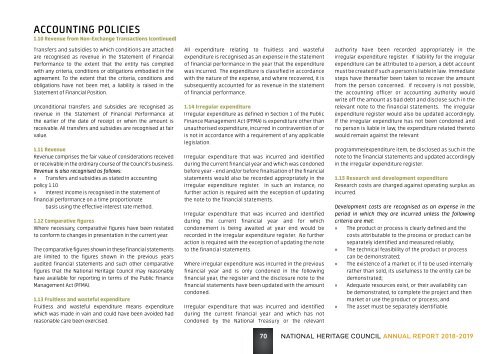2018-19 Annual Report
You also want an ePaper? Increase the reach of your titles
YUMPU automatically turns print PDFs into web optimized ePapers that Google loves.
ACCOUNTING POLICIES<br />
1.10 Revenue from Non-Exchange Transactions (continued)<br />
Transfers and subsidies to which conditions are attached<br />
are recognised as revenue in the Statement of Financial<br />
Performance to the extent that the entity has complied<br />
with any criteria, conditions or obligations embodied in the<br />
agreement. To the extent that the criteria, conditions and<br />
obligations have not been met, a liability is raised in the<br />
Statement of Financial Position.<br />
Unconditional transfers and subsidies are recognised as<br />
revenue in the Statement of Financial Performance at<br />
the earlier of the date of receipt or when the amount is<br />
receivable. All transfers and subsidies are recognised at fair<br />
value.<br />
1.11 Revenue<br />
Revenue comprises the fair value of considerations received<br />
or receivable in the ordinary course of the Council’s business.<br />
Revenue is also recognised as follows:<br />
»»<br />
Transfers and subsidies as stated in accounting<br />
policy 1.10<br />
»»<br />
Interest income is recognised in the statement of<br />
financial performance on a time proportionate<br />
basis using the effective interest rate method.<br />
1.12 Comparative figures<br />
Where necessary, comparative figures have been restated<br />
to conform to changes in presentation in the current year.<br />
The comparative figures shown in these financial statements<br />
are limited to the figures shown in the previous years<br />
audited financial statements and such other comparative<br />
figures that the National Heritage Council may reasonably<br />
have available for reporting in terms of the Public Finance<br />
Management Act (PFMA).<br />
1.13 Fruitless and wasteful expenditure<br />
Fruitless and wasteful expenditure means expenditure<br />
which was made in vain and could have been avoided had<br />
reasonable care been exercised.<br />
All expenditure relating to fruitless and wasteful<br />
expenditure is recognised as an expense in the statement<br />
of financial performance in the year that the expenditure<br />
was incurred. The expenditure is classified in accordance<br />
with the nature of the expense, and where recovered, it is<br />
subsequently accounted for as revenue in the statement<br />
of financial performance.<br />
1.14 Irregular expenditure<br />
Irregular expenditure as defined in Section 1 of the Public<br />
Finance Management Act (PFMA) is expenditure other than<br />
unauthorised expenditure, incurred in contravention of or<br />
is not in accordance with a requirement of any applicable<br />
legislation.<br />
Irregular expenditure that was incurred and identified<br />
during the current financial year and which was condoned<br />
before year - end and/or before finalisation of the financial<br />
statements would also be recorded appropriately in the<br />
irregular expenditure register. In such an instance, no<br />
further action is required with the exception of updating<br />
the note to the financial statements.<br />
Irregular expenditure that was incurred and identified<br />
during the current financial year and for which<br />
condonement is being awaited at year end would be<br />
recorded in the irregular expenditure register. No further<br />
action is required with the exception of updating the note<br />
to the financial statements.<br />
Where irregular expenditure was incurred in the previous<br />
financial year and is only condoned in the following<br />
financial year, the register and the disclosure note to the<br />
financial statements have been updated with the amount<br />
condoned.<br />
Irregular expenditure that was incurred and identified<br />
during the current financial year and which has not<br />
condoned by the National Treasury or the relevant<br />
70<br />
authority have been recorded appropriately in the<br />
irregular expenditure register. If liability for the irregular<br />
expenditure can be attributed to a person, a debt account<br />
must be created if such a person is liable in law. Immediate<br />
steps have thereafter been taken to recover the amount<br />
from the person concerned. If recovery is not possible,<br />
the accounting officer or accounting authority would<br />
write off the amount as bad debt and disclose such in the<br />
relevant note to the financial statements. The irregular<br />
expenditure register would also be updated accordingly.<br />
If the irregular expenditure has not been condoned and<br />
no person is liable in law, the expenditure related thereto<br />
would remain against the relevant<br />
programme/expenditure item, be disclosed as such in the<br />
note to the financial statements and updated accordingly<br />
in the irregular expenditure register.<br />
1.15 Research and development expenditure<br />
Research costs are charged against operating surplus as<br />
incurred.<br />
Development costs are recognised as an expense in the<br />
period in which they are incurred unless the following<br />
criteria are met:<br />
»»<br />
The product or process is clearly defined and the<br />
costs attributable to the process or product can be<br />
separately identified and measured reliably;<br />
»»<br />
The technical feasibility of the product or process<br />
can be demonstrated;<br />
»»<br />
The existence of a market or, if to be used internally<br />
rather than sold, its usefulness to the entity can be<br />
demonstrated;<br />
»»<br />
Adequate resources exist, or their availability can<br />
be demonstrated, to complete the project and then<br />
market or use the product or process; and<br />
»»<br />
The asset must be separately identifiable.


